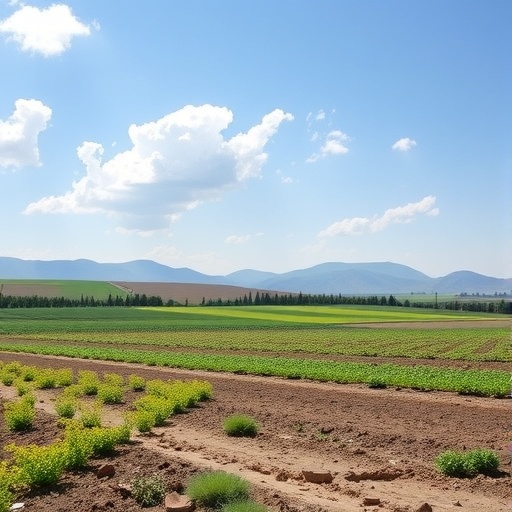In a groundbreaking study, researchers have delved into the geochemical dynamics of phosphorus concentration, its origins, and spatial distribution within the soils of the Ararat Valley, Armenia. This valley, renowned not only for its scenic beauty but also as a significant agricultural zone, has become the focal point for understanding the nutrient profiles crucial for both ecological sustainability and agricultural productivity. By employing advanced geochemical analysis techniques, the research team, led by D. Pipoyan, G. Tepanosyan, and A. Gevorgyan, provides a detailed insight that is poised to transform practices in soil management and conservation in the region.
Phosphorus, one of the primary macronutrients essential for plant growth, plays a vital role in various biological processes, including photosynthesis, energy transfer, and overall plant metabolism. Consequently, its concentration in soil directly influences agricultural yield and ecological health. The research highlights that phosphorus levels in the Ararat Valley exhibit variability influenced by numerous factors, including parent material, topography, land use practices, and climatic conditions. This multifaceted nature makes phosphorus dynamics a compelling subject for exploration, particularly in developing sustainable agricultural practices.
The study harnesses an array of geochemical and statistical methodologies to assess phosphorus levels across various sampling sites in the valley. By analyzing soil samples collected from diverse locations, the research team meticulously documents variances in phosphorus concentration that could offer vital insights into underlying soil formation processes and historical land use. The findings reveal a complex interplay between natural soil composition and anthropogenic activities, enhancing our understanding of both local and regional soil fertility dynamics.
Intriguingly, the research points out that the origin of phosphorus in the Ararat Valley is not solely geological. Instead, the contributions from agricultural practices, particularly the use of fertilizers, present significant impacts on phosphorus levels. This anthropogenic influence raises critical questions about sustainability practices and the necessity of balancing nutrient input with ecological integrity. The study underscores the need for developing tailored nutrient management strategies that consider both natural and human-induced factors affecting phosphorus dynamics.
Moreover, the spatial distribution of phosphorus within the valley’s soil shows that certain areas are particularly rich in phosphorus, while others are deficient. These disparities may correlate with historical land use patterns, including shifts from traditional farming methods to more intensive agricultural practices. Understanding these patterns is crucial for policymakers and farmers looking to optimize land use while ensuring the long-term viability of agricultural productivity.
The research team’s findings suggest various strategies to mitigate phosphorus deficiency in soils and enhance agricultural efficiency. Recommendations include the careful application of fertilizers, the incorporation of organic amendments, and rotation practices that not only increase phosphorus availability but also foster soil health. The need for educational outreach to farmers about the implications of phosphorus management is underscored, highlighting the importance of community involvement in implementing sustainable agricultural practices.
This first-of-its-kind research presents a vital contribution to the environmental science community, especially in the context of soil chemistry and land use management. The findings serve as a reference point for future studies aiming to further explore nutrient cycles in agricultural soils, particularly within similar geographic and climatic contexts. The study paves the way for subsequent investigations that could expand our knowledge of nutrient dynamics beyond phosphorus, thereby fostering a holistic approach to soil health.
In addressing the implications of phosphorus concentration and its management, the researchers advocate for a multi-disciplinary approach that incorporates ecological, agronomic, and geochemical perspectives. They emphasize that successful nutrient management requires collaboration among scientists, farmers, and policymakers to create effective frameworks that prioritize ecological balance alongside agricultural productivity.
The research also opens avenues for future studies examining the broader ecological impacts of phosphorus management practices over time. By adopting a longitudinal approach, scientists can monitor changes in soil chemistry and its subsequent effects on crop yield and ecosystem health. This forward-thinking perspective could yield invaluable data, contributing to a deeper understanding of sustainable farming practices in the face of changing climate conditions.
Notably, the significance of the Ararat Valley extends beyond local agriculture; it serves as a case study for regions grappling with similar challenges of nutrient management in soils worldwide. The insights gleaned from this study are likely to resonate with global agricultural practices, prompting further research into effective soil management strategies that are environmentally sustainable and economically viable.
This study ultimately contributes to the ongoing discourse on phosphorus research within the context of food security, climate change, and sustainable development. It raises critical awareness about the need to harmonize agricultural practices with environmental stewardship, encouraging a shift towards more responsible management of soil nutrients. As the world faces increasing pressures on food production systems, understanding the nuances of soil health becomes imperative in ensuring a sustainable future for agricultural practices.
In summary, the investigation into phosphorus in the soils of the Ararat Valley represents a significant advancement in our understanding of geochemical dynamics. This fundamental research not only sheds light on critical nutrient issues but also emphasizes the interconnectedness of ecology and agriculture. As we continue to seek solutions to pressing global challenges, studies like this pave the way for informed decision-making and enhanced agricultural sustainability.
Subject of Research: Geochemical insight into phosphorus concentration and distribution in soil.
Article Title: First geochemical insight into phosphorus (P) concentration, origin, and spatial distribution in the soils of the Ararat Valley (Armenia).
Article References:
Pipoyan, D., Tepanosyan, G., Gevorgyan, A. et al. First geochemical insight into phosphorus (P) concentration, origin, and spatial distribution in the soils of the Ararat Valley (Armenia).
Environ Monit Assess 197, 1224 (2025). https://doi.org/10.1007/s10661-025-14675-2
Image Credits: AI Generated
DOI: 10.1007/s10661-025-14675-2
Keywords: phosphorus, geochemistry, soil analysis, Ararat Valley, agricultural sustainability




